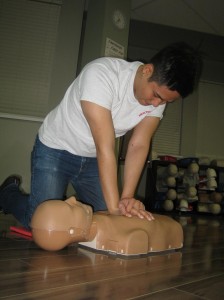Participants enrolled in standard first aid training (courses now available in Regina) will learn to demonstrate the effective direction of bystanders to activate emergency medical services (EMS). Bystander play an effective and necessary role. Rescuers, whenever possible and safe to do so, will tend to the consenting victim, however, if EMS is necessary, rather than the rescuer contact EMS, the rescuer can send a bystander.
The process of contacting a bystander by a rescuer must include:
- The rescuer must identify a specific bystander or bystanders.
- The rescuer must have effective two-way communication with the bystander.
CPR training is included in standard first aid courses. - A clear demonstration of effective direction to call EMS. The rescuer must inform the bystander with information on what happened, the location and what is being done for the patient(s). In order to know if the bystander successfully completed the task, the rescuer will inform the bystander to report back once the task has been completed. If the rescuer is unsure that the bystander can complete the task the rescuer can send more bystanders.
- Clear directions to the bystander to locate and bring a automated external defibrillator (AED).
- A effective use of a bystander.
Candidates in a standard first aid course must also be able to determine which circumstances require a call to EMS. Participants will also have to show the instructor a simulated EMS call in which candidates will provide the why, what, where and who about the emergency situation.
Additional notes to standard first aid participants:
- Contact EMS as soon as a serious or life-threatening condition is discovered. When in doubt, contact EMS. Not all scenarios require EMS.
- If no bystanders are present and the victim is a adult, contact EMS and retrieve a AED if immediately available prior to any first aid or CPR treatment.
- If alone with a child or infant, rescuers must attempt 2 minutes of CPR prior to calling EMS and retrieving a AED if immediately available.
- All unconscious victims should be left in the recovery position.
- When contacting EMS always hang up last.
- Candidates can ask bystander to repeat information given to show understanding.
Participants should have a strong understanding of contacting EMS and using a bystander effectively in a first aid or emergency scenario. All of the topics mentioned above will be covered in a standard first aid course.
